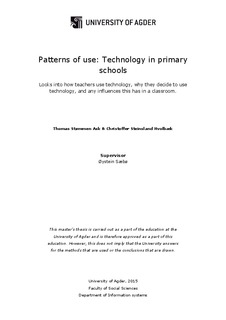| dc.contributor.author | Ask, Thomas Stømmen | |
| dc.contributor.author | Hvolbæk, Christoffer Steinsland | |
| dc.date.accessioned | 2015-09-14T06:46:03Z | |
| dc.date.available | 2015-09-14T06:46:03Z | |
| dc.date.issued | 2015 | |
| dc.identifier.uri | http://hdl.handle.net/11250/299652 | |
| dc.description | Masteroppgave informasjonssystemer- Universitetet i Agder, 2015 | nb_NO |
| dc.description.abstract | In this study we wanted to look at what types of patterns of use we could find when looking at available technology in the primary schools in Kristiansand. An ICT manager in the municipality was first contacted to obtain existing data that was available in these areas. Our first thought was to look at what type of technology was available in schools in Kristiansand, but following an evaluation of the information collected from the ICT manager we instead chose to look at the use patterns. A good bit of the existing research focuses on older pupils, and this made it more it interesting for us to look at how patterns of use prevailed in primary schools. We ended up formulating our research question like this: What are the potential patterns of use for modern technology in primary schools?
During this thesis we have learned that why teachers use technology, and how it effects the classroom teaching is part of what creates patterns. Patterns of use varies from class to class and from the type of equipment available. There are many different factors that influence how and when a teacher can use technology, but it can be a great tool to enhance the classroom teaching. Patterns we have seen are amongst many the possibility to let pupils interact with a SMART board to solve tasks and present material in front of a class. The use of iPads to learn material in new and exciting ways and working on computers to learn a basic for what will become important later in life. The possibilities are almost endless; a lot of it comes down to having a motivated teacher and a school that is committed to technology so that they get the right equipment.
We have worked on this study with an interpretative research approach, using qualitative method as the bases for collection and handling data. We performed two interviews and one observation with each teacher; one interview before the observation and one after. Inspired by grounded theory we used an open-minded interview approach, transcribing after every interview to facilitate a choice of changing or updating one or more questions for the next interview. Observation was carried out using overt participant observation techniques, including us in the classrooms and getting the data first hand. Inspired by grounded theory we used open coding, axial coding and selective coding to sort and analyse the data collected from the interviews and observations.
We talked to and observed four teachers at different schools to find a pattern on how they used technology in classroom teaching. Our selection of teachers was based on whether they used technology on a day-to-day basis. We wanted to observe and experience technology that was actively in use and ended up with schools that we knew had a high technology usage with teachers that used technology in their classroom teaching. Our group of teachers all had different backgrounds and work experience, making them a diverse sample. SMART board, iPad, laptop and PC were the most used technology. | nb_NO |
| dc.language.iso | eng | nb_NO |
| dc.publisher | Universitetet i Agder ; University of Agder | nb_NO |
| dc.subject.classification | IS 501 | |
| dc.title | Patterns of use: Technology in primary schools Looks into how teachers use technology, why they decide to use technology, and any influences this has in a classroom. | nb_NO |
| dc.type | Master thesis | nb_NO |
| dc.subject.nsi | VDP::Technology: 500::Information and communication technology: 550 | nb_NO |
| dc.source.pagenumber | 85 s. | nb_NO |
